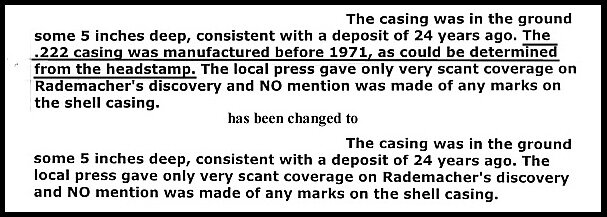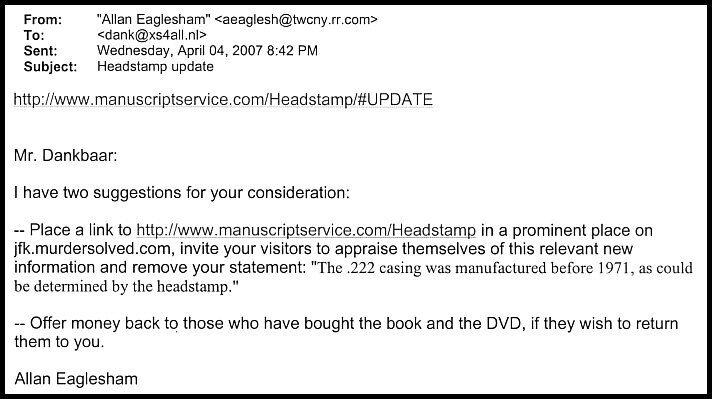BRIEF CONTEXT
In 1987, John Rademacher dug up two .222-caliber cartridge cases from the north side of Dealey Plaza [1]. One was located about 10 ft east of the picket fence close to the pergola, and the other was some 60 ft to the northeast [2]. Subsequently, Mr. Rademacher was introduced to Kennedy-assassination eyewitness Malcolm Summers by investigator Joe West. From photographs provided by Rademacher of weapons that fire .222 rounds, Mr. Summers identified a Remington XP-100 Fireball pistol as similar to what he had seen in the possession of a man on the north side of Elm Street shortly before the assassination [3].
In 1992, Mr. West was given a lead on the Kennedy assassination by FBI agent Zechariah (Zack) Shelton that led West to James Files, serving a 30-year sentence in Statesville Prison, Joliet, IL, for attempted murder of two policemen in 1991. In August 1992, West visited Joliet and heard a partial confession from Files [1,4]. Joe West died six months later, and the investigation was assumed by Bob Vernon. Mr. Vernon met with Files in Statesville in May of 1993, to be told that he (Files) had assassinated the president with an XP-100 Fireball, modified to fire .222 cartridges [1] (rather than .221). Furthermore, Vernon was told that if the cartridge case from the round fired by Files were ever found, it would have teeth-marks on it [1] because Files had bitten down on it (and left it on the picket fence) [4]. Vernon then contacted and visited Rademacher in Texas, and discovered that the cartridge case found near the picket fence was, indeed, dented as Files had predicted [1].
In 2003, Bob Vernon sold his rights to the Files story to Willem (Wim) Dankbaar, who now manages jfkmurdersolved.com where the book Files on JFK: Interviews with the Confessed Assassin James E. Files [5] and the DVD I Shot JFK: The Real Murderer Reveals His Secret [6] are available for purchase.
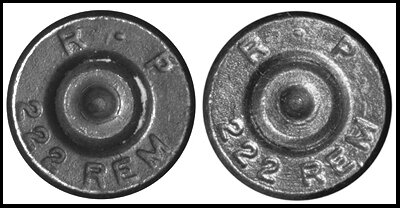
Figure 1. Headstamps of the cartridge cases found by John Rademacher [7].
IS JAMES FILES TELLING THE TRUTH?
On his website, Mr. Dankbaar has a detailed article titled Is James Files telling the truth? which includes a close-up of the cartridge case unearthed near the picket fence by John Rademacher, clearly showing two indentations on the open end [4]. The article states: "The .222 casing was manufactured before 1971, as could be determined from the headstamp." No photograph of the headstamp is provided, but I had a jpeg on my computer showing both of Rademacher s finds (Fig. 1); Dankbaar's reason for ascribing a pre-1971 date is non-obvious.
A telephone conversation with Bob Vernon revealed that a Remington Arms representative initially told him that the Rademacher cartridge cases were manufactured in the 1960s, as revealed by the length of the dash between the "R" and the "P" on the headstamps. Later, however, word came from Remington that an error had been made; the length of the dash revealed that the cartridge cases had been made after operations were moved from Bridgeport, CT, to Lonoke, AR, in 1971. If the cartridge cases had been manufactured in the 1960s, the dash would have been the same length as the height of the "R" and the "P": 0.04 inches. Subsequent to the move to Arkansas, the dash was shortened, as on the Rademacher headstamps (Fig. 2).
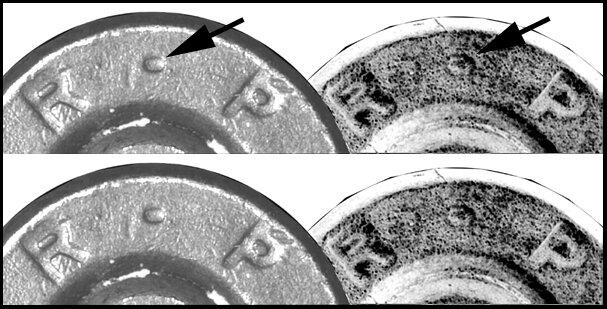
Figure 2. Headstamps of the Rademacher cartridge cases modified to emphasize the dashes.
Vernon recalls a telephone conversation shortly before the sale of JFK Murder Solved in which he told Dankbaar that he (Dankbaar) may have bought two worthless pieces of metal and that James Files might be working a hoax. The two men also discussed the possibility that Remington's change of information might signify an effort to conceal the truth.
CORROBORATIVE PHYSICAL EVIDENCE?
The situation was left unresolved and the sale made. Vernon moved on to other endeavors and Dankbaar assumed responsibility for jfkmurdersolved.com. His words there -- "The [dented] .222 casing was manufactured before 1971, as could be determined by the headstamp" [4] -- suggest that he researched the issue and verified that the dented cartridge case found by Mr. Rademacher is, indeed, physical evidence corroborative of James Files' claim of being the man who killed Kennedy. But if the headstamp shows that the dented cartridge case is of 1960s vintage, why not provide elucidation to justify the statement?
Surely it would be a simple matter to determine whether the Rademacher cartridge cases could have been deposited in Dealey Plaza in 1963. I decided to bite the bullet.
THE SEARCH
I contacted Remington Arms via their website -- requesting photographs of R-P headstamps before and after the change of manufacturing venue in 1971 -- and was told that company policy is to provide such information only to law-enforcement agencies.
Googling "cartridges" indicated that Cartridges of the World: A Complete and Illustrated Reference for over 1500 of the World s Most Important Sporting Cartridges might provide the information [8]. I was able to purchase it second-hand for $10. Only three of the 500 pages deal with headstamps, and only in generic terms. However, the bibliography includes the Cartridge Headstamp Guide [9] which looked interesting, particularly if an edition exists later than 1963 as listed. An internet search of used-book sites revealed that a 1977 edition is available; however, both editions are rare and priced in excess of $200.
I put in a request for an interlibrary loan via the local library, and 3 weeks later collected a copy of CHG in exchange for the princely sum of fifty cents. However, I was soon disappointed to find that it was the 1963 edition, not the 1977 edition specified on the request. The only notation for R-P is shown in Fig. 3.
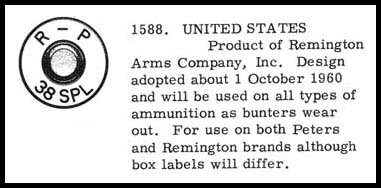
Figure 3. Entry on the R-P headstamp in the 1963 edition of Cartridge Headstamp Guide [9].
The length of the dash in Fig. 3 is consistent with what Bob Vernon was told by the Remington representative: about the same as the height of the "R" and the "P." I renewed the interlibrary loan request in the hope of obtaining the 1977 edition.
A "cartridge headstamp" search on Google as a whole -- not just used-book sites -- revealed the availability of a CD titled Cartridge Headstamp & Measurement Guide by Curtis Steinhauer [10]. It arrived in the mail within two weeks of placing an order. The CD provides photographs of three R-P headstamps, each with a short dash (Fig. 4) with the notation, "Headstamp used on cartridges since 1960 (the merger of Peters into the Company)," with the location of manufacture stated as "Remington Arms Co., Bridgeport, CT" ; there is no mention of Lonoke, AR.
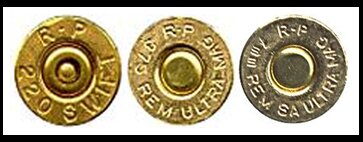
Figure 4. R-P headstamps in Cartridge Headstamp & Measurement Guide [10].
Mr. Steinhauer clarifies that the "R-P" notation on Remington headstamps originated in 1960, prior to which "REM-UMC" had been used since 1911 (Fig. 5), demonstrating that the cases found by Mr. Rademacher were not manufactured prior to 1960.

Figure 5. Pre-1960 Remington headstamps in Cartridge Headstamp & Measurement Guide [10].
The information provided by Mr. Steinhauer -- at odds with that of White and Munhall -- indicates that the Radenbacher cartridge cases could have been manufactured prior to November 1963. However, if the short dash shown by Steinhauer on the R-P cases in Fig. 4 has been used for the past 46 years, it begs the question of how Mr. Dankbaar would know from the headstamp on the dented Rademacher cartridge case that it dates from before 1971.
Another Google search revealed a webpage run by "Ammo Guy" at http://oldammo.com/. Guy Hildebrand's list of items for sale included these:
.222 Remington, copper jacket soft point, copper primer, headstamp R-P 222 REM $1.00
.222 Remington, copper jacket hollow point, copper primer, headstamp R-P 222 REM $1.00
I emailed, asking if he had R-P cartridges from the 1960s and 1970s to allow comparison of headstamps. Mr. Hildebrand replied that he was unaware that a headstamp change had occurred with Remington s move from Bridgeport to Lonoke. I was grateful to him for informing me that the 1977 edition of Cartridge Headstamp Guide has the same information on R-P cartridges as does the 1963 edition (which I later confirmed). I was grateful to him also for suggesting that I seek information on the Cartridge Forum at the website of the International Ammunition Association.
I registered with the forum and posted (Fig. 6).
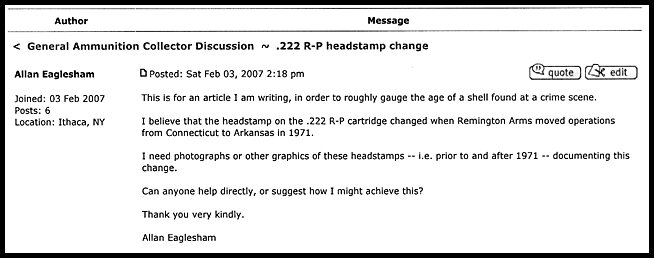
Figure 6. Message posted on the cartridge forum of the International Ammunition Association.
No hint was given of the nature of the putative change in the headstamp. Later that day, the messages below were posted by a forum member and a forum administrator. They are consistent with the White & Munhall sketch (Fig. 3) and with what Mr. Vernon had been told by Remington. The short dash on the Rademacher cartridge cases indicates that they were manufactured in 1971 or later:
1. Remington used R . P instead of R - P for production at the Lonoke, Arkansas plant.
2. According to my notes: 1970, centerfire ammunition production was moved to Lonoke Arkansas. December 1989, the Bridgeport plant was closed down and all ammunition was produced at Lonoke. R - P Remington Peters, Bridgeport, CT c.1960-1989 R . P Remington Peters, Lonoke, AR c.1970-date
A member of the forum sent a private email with the address of someone who might be able to help. Although unable to assist directly, that individual provided the address of someone else who answered my email with an attached file containing the drawing shown in Fig. 7. It provides better documentation than photographs.
RESOLUTION
The drawing (Fig. 7) had been salvaged from trash by a former Remington employee who gave it to the person who so kindly shared it with me. It shows the drawing matrix for heading bunter E1258-1 for the .222 Remington cartridge. The drawing was made, traced, checked and approved on 4-14-60, shortly after which Remington changed from "Rem-UMC" (see Fig. 5) to "R-P" headstamps. The second line of "RECORD OF ALTERATIONS" states: "98719 .015 was .040 12-30-70 F.L.C.Y." (emphasis added) (Fig. 7 inset). This refers to a change in the length of the dash between the "R" and the "P" from 0.040 inches to 0.015 inches; note that ".015" is underlined on the drawing, denoting where the change was to be made on December 30, 1970. Note also, that the dash at 0.04 inches was the same length as the height of the "R." (This design, in turn, was "SUPERSEDED" by another, designated D3034-28, on 10/5/73, as shown by the notation upper-left of the circle.)
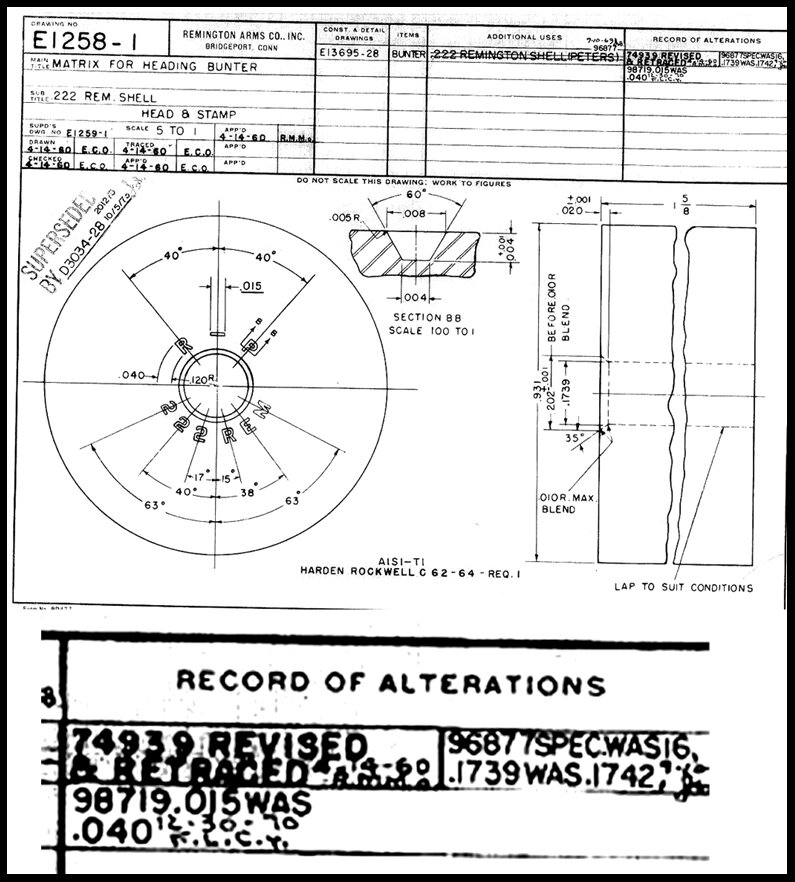
Figure 7. 1960 drawing matrix for the Remington Arms .222 cartridge headstamp [11].
In short, the long dash -- 0.04 inches in length -- was used on .222 cartridge headstamps throughout the 1960s. The dash was shortened to 0.015 inches in 1970.
The cartridge cases found in Dealey Plaza by John Rademacher were manufactured in 1971 or later. The dented cartridge case has nothing to do with James Files or the assassination of President Kennedy.
CONCLUSION
The apparently conflicting information in Cartridge Headstamp Guide and Cartridge Headstamp & Measurement Guide almost precluded a firm determination of the decade in which the Rademacher shells were manufactured. Resolution resulted perhaps from luck, but certainly from generosity from people I have never met.
Wim Dankbaar stated [4]: "The shell casing is...a crucial piece of physical evidence for [Files'] credibility." In my opinion it stretches credulity beyond a reasonable doubt that two similarly dented Remington .222 cartridge cases lay in the vicinity of the picket fence in Dealey Plaza, one used by James Files to assassinate President Kennedy and the other (presumably deposited by happenstance) used to attempt to prove his culpability in that crime. In my opinion, Files is a fraud and the onus is now on Mr. Dankbaar* to justify his statement, "The .222 casing was manufactured before 1971, as could be determined by the headstamp" [12].
(*Note added April 10, 2007: Mr. Dankbaar has deleted this sentence -- please see here.
NOTES
[1] John Rademacher and the .222 Casing. (http://www.jfkmurdersolved.com/radtruth.htm)
[2] Distances are estimated by comparing Mr. Rademacher's map at www.jfkmurdersolved.com/radtruth.htm with Richard Trask's map in Pictures of the Pain, Yeoman Press 1994, which includes a scale reference.
[3] It is noteworthy that in a statement given to Dallas police on the day after the assassination, Mr. Summers made no mention of this man: Yesterday, November 23 [sic], 1963, I was standing on the terrace of the small park on Elm Street to watch the President's motorcade. The President's car had just come up in front of me when I heard a shot and saw the President slump down in the car and heard Mrs. Kennedy say, "Oh, no," then a second shot and then I hit the ground as I realized these were shots. Then all of the people started running up the terrace away from the president's car and I got up and started running also, not realizing what had happened. In just a few moments the president's car sped off and everyone was just running around towards the railroad tracks and I knew that they had somebody trapped up there. I imagine I stayed there 15 or 20 minutes and then went over on Houston Street to where I had my truck parked..."
[4] Is James Files telling the truth? (http://www.jfkmurdersolved.com/filestruth.htm)
[5] Files on JFK. (http://www.jfkmurdersolved.com/buy2.htm)
[6] I Shot JFK. (http://www.jfkmurdersolved.com/dvd.htm)
[7] Permission to use the photograph in Fig. 1 was granted by Wim Dankbaar on condition that he have the opportunity to respond.
[8] Barnes FC McPherson ML (2000) Cartridges of the World: A Complete and Illustrated Reference for over 1500 of the World s Most Important Sporting Cartridges, 9th Edition. Krause Publications, Iola, WI.
[9] White HP Munhall BD (1963 & 1977) Cartridge Headstamp Guide. H.P. White Laboratory, Inc., Bel Air, MD.
[10] Steinhauer C (2006) Cartridge Headstamp & Measurement Guide. (www.cartridge-corner.com)
[11] This article was sent to Remington Arms. They had no objection to use of this drawing.
[12] See endnote [7]. Permission to use the photograph in Fig. 1 was sought from Mr. Dankbaar on January 24, 2007: I am planning an article (for my website and submission to JFK/Deep Politics Quarterly) on the implications of the Rademacher shells for James Files' claims. May I have your permission to use the photograph in the attached file? He responded: Sure, but only if you show me your article first and publish my (possible) comments as well. Accordingly, on February 26, 2007, I emailed him a draft, stating: Per our agreement, resulting from my use of your photograph of the Rademacher shells, please find the article in the attached file. Please acknowledge receipt, and inform me as soon as possible if you plan to write a response for possible inclusion in JFK/DPQ. I say "possible" because Walt Brown has not committed to publishing the article. That is his decision and his alone, and he has not seen [the article] until now. Dankbaar responded: Please copy paste the article in an email, I cannot read articles in PDF format at this time. My internal bullcrap indicator went into "alarm" mode, but I gave him the benefit of the doubt and sent him a Word document, knowing that placement in an email would scramble the formatting. Next morning, I followed up with: Did you receive the article in Word? Do you plan to respond in writing? He replied: I have already made a start on my forum. Without seeking permission, he had posted the article on the internet -- without graphics, therefore meaningless to his subscribers -- emphasizing minor inaccuracies (now corrected) and finessing the relevance of the drawing (http://www.jfkmurdersolved.com/phpBB2/viewtopic.php?p=4160#4160). In response to the final sentence of the article, he put his foot in his mouth with these words: Good, I gladly take that challenge and invite everyone to help. There surely must be cartridge collectors who still have casings from the 1960's to compare. Dankbaar's request for "everyone to help" reveals that he has no justification for his statement, "The .222 casing was manufactured before 1971, as could be determined from the headstamp." Apparently, these words are based on wishful thinking that the original information from Remington Arms was and is accurate, and he chose to ignore Bob Vernon's warning that the Rademacher cartridge cases might have been manufactured in 1971 or later and that Files might be perpetrating a hoax.
Top of the Page
SELECTED COMMENTS
Bob Vernon: "...compliments on your research and diligent efforts...your work on the dash speaks for itself..."
Mr. Vernon's comments in full are here.
Dave Ostertag: "Very good job of research."
Mr. Ostertag's comments in full are here.
Tim Carroll: "My hat's off to a real researcher..." (JFK Lancer Research Forum)
Bruce Kelly: "Another brilliant, dogged piece of research." (JFK Lancer Research Forum)
Gary Murr: "This is what true 'research' is all about." (JFK Lancer Research Forum)
Wim Dankbaar: (Feb. 27) "This is going to be a cold shower for Mr. Eaglesham**." (JFK Murder Solved Forum)
"Bob": "Sometimes a name is all you need to know about someone. Case in point...EagleSHAM.(JFK Murder Solved Forum)
Bruce Patrick Brychek: "I think that it is also important that I convey to the JFK Forum Members how much Eaglesham has attacked and attempted to villify another close personal friend of mine along with Wim Dankbaar, and Jimmy Files. That other person is none other than Lieutenant Colonel Dangerous Dan Marvin who has a career better than any Hollywood writers could ever imagine. Dan was attacked endlessly until Dan beat the CIA and Special Forces in Federal Court last year in New York. Since then, Eaglesham has shut his trap on Dan. Wim, being attacked by Eaglesham is to a degree a compliment. He attacks the biggest, and best. Then looses [sic]." (JFK Murder Solved Forum)
Paul Pennyworth: "Between the JFK Lancer board and this one, JFK Murder Solved is definitely the much better board. We are connecting the dots here whereas the other board isn't ..and as for this Eaglesham I never even heard of him. Who cares if he has a phd..Nixxon was a lawyer...there's a whole bunch of Jerry's kids with degrees..maybe it the family money that did it" (JFK Murder Solved Forum)
Jack White: "That should rid us of the Files fiction. Thanks, Allan." (The Education Forum / JFK Assassination Debate)
Wim Dankbaar: "Eaglesham's claim is a nice try, but still bull." (The Education Forum / JFK Assassination Debate)
(**December 1, 2008: AE awaits the cold shower. The interested reader would be justified
in concluding that Dankbaar has no answer. Yet, his website continues to proclaim:
Dallas man and son dig up casing that killed JFK! Assassin identifies it as his!
Integrity? The Dutchman wouldn't recognize it if it bit him where the sun don't shine.)
Top of the Page
UPDATE-1 (April 4, 2007)
An Internet search of ammunition sites for .222 REM R-P cartridges manufactured in the 1960s and the 1970s confirmed that buying specific old ammo is less than easy. After several tries I came across this:
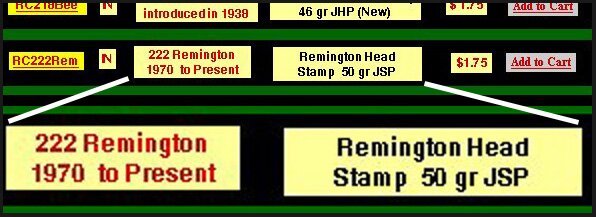
at http://www.ammo-one.com/0.html
I purchased five, sight-unseen (deactivated). Each has a short dash:
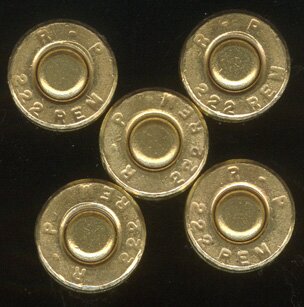
Shortly after, I came across a reference to:

where Mr. Roth told me that he had 1960s-vintage cartridges. Again, I bought them sight-unseen, a dozen this time (again deactivated). Each has a long dash:
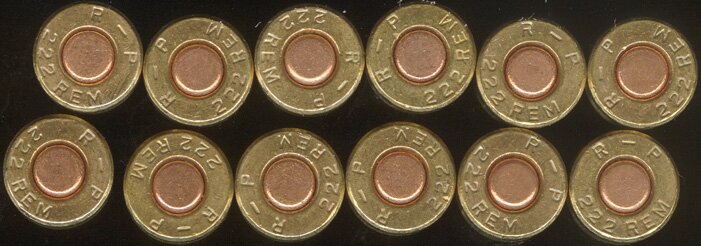
The box containing these cartridge cases indicates that they were manufactured in Bridgeport, CT.

Thus, there is consistency. As more information is obtained, the evidence becomes ever stronger that the dented cartridge case found by John Rademacher on the grassy knoll in Dealey Plaza was manufactured years after 1963.
UPDATE-2 (April 27, 2007)
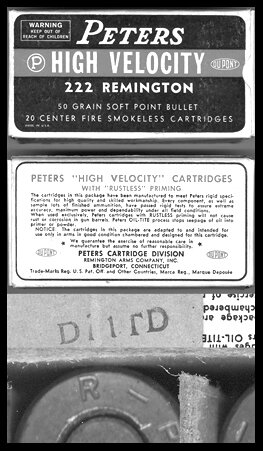
|
On April 14, 2007, the graphic on the left was emailed to Remington with the request that the date of manufacture of the cartridges/box (see above) be provided.
On April 16, Remington responded: "Unfortunately, much of our research material is dedicated to firearms and we are only beginning to archive information about ammunition...We suggest that you contact the Remington Society of America..."
On April 26, the message below was received via Mike, a representative of the Remington Society of America.
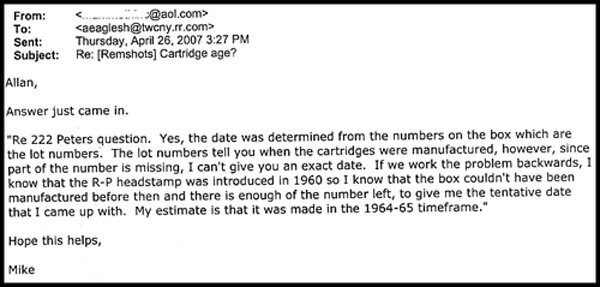
The box was manufactured in the mid-1960s. Presumably the cartridges it contained were manufactured then also.
|
|


